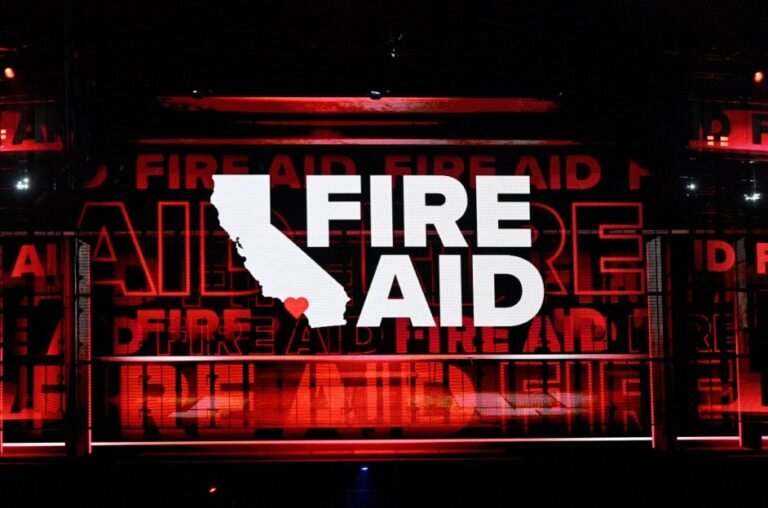FireAid Refutes ‘Misinformation’ Claims About L.A. Wildfire Relief Fund Distribution in Official Statement…see more…
In response to growing public scrutiny and social media speculation, FireAid, the nonprofit organization at the center of L.A. wildfire relief efforts, has issued a formal statement disputing what it calls “misinformation and false narratives” about how it has distributed funds raised during recent campaigns. The organization, known for coordinating emergency aid and fundraising during natural disasters, is under fire from critics who claim that millions of dollars donated for wildfire victims have yet to reach the affected communities.
The controversy began earlier this month when several viral posts on X (formerly Twitter) accused FireAid of withholding donations or misallocating funds intended for victims of the 2025 Los Angeles County wildfires. These fires, which ravaged neighborhoods in Topanga Canyon, Malibu, and the San Fernando Valley, destroyed over 3,000 homes and displaced tens of thousands of residents.
One widely circulated post alleged that less than 10% of the over $12 million raised by FireAid had actually been distributed to individuals or communities in need. Others questioned the nonprofit’s leadership salaries, administrative expenses, and partnerships with private contractors.
In a press release published Friday, FireAid called these allegations “irresponsible and deeply damaging,” emphasizing that over 70% of funds raised had already been deployed or allocated through direct grants, supply distributions, and community recovery programs.
> “We categorically reject the misinformation being circulated online,” the statement read. “FireAid has always operated with transparency and in close coordination with local officials, fire departments, and trusted community organizations. These baseless accusations not only distract from the ongoing recovery efforts but also undermine public trust during a critical time.”
According to the organization’s report, $8.6 million of the funds raised have gone toward temporary housing stipends, emergency supply kits, school support for displaced children, and infrastructure support in high-risk fire zones. The remaining funds, FireAid says, are earmarked for long-term rebuilding efforts and are scheduled for phased release over the next six to 12 months.
Despite the statement, some critics remain unconvinced. Local activist group LA Wildfire Watch issued a rebuttal calling for an independent audit of FireAid’s financial records and real-time public tracking of fund distribution.
> “We appreciate the work FireAid has done historically,” said Maria Sandoval, the group’s spokesperson. “But when communities are hurting and millions of dollars are raised in their name, transparency must go beyond general statements. The public deserves detailed, line-item accounting and a clear picture of where the money is going.”
Sandoval’s concerns reflect a wider sentiment growing among residents of wildfire-stricken areas, many of whom say they have seen little to no assistance despite the huge sums raised.
Jamie Collins, a single mother from Calabasas whose home was destroyed, said she’s grateful for the community support but feels abandoned by official channels.
> “People have been generous, donating clothes and food. But where is the money we were promised?” Collins asked. “We keep hearing about millions raised, but I’m still sleeping on my cousin’s couch with no answers.”
In response, FireAid’s CEO, DeShawn Harper, held a live Q&A session streamed on the organization’s website Friday evening. Harper addressed questions submitted by the public and emphasized that the relief process involves coordination with dozens of agencies, local governments, and housing departments, all of which take time to mobilize.
> “We understand the urgency and the pain families are facing,” Harper said. “But rebuilding lives and communities is not as simple as writing a check. We must ensure funds are used responsibly, equitably, and in ways that have lasting impact.”
Harper also announced the launch of a new public dashboard, scheduled to go live next week, which will allow users to track every dollar raised and spent. The dashboard will include breakdowns by category—such as emergency housing, medical assistance, education support, and community grants—as well as updates on projects in progress.
Several local leaders have come to FireAid’s defense, including Los Angeles Mayor Karen Bass, who praised the organization’s history of effective disaster response.
> “FireAid has been a crucial partner in helping our city navigate some of its darkest days,” Bass said during a press conference Saturday. “Are there improvements to be made? Of course. But I have full confidence in their commitment to transparency and accountability.”
In addition, the Los Angeles County Board of Supervisors announced that they would be reviewing disaster relief procedures across all partner organizations to ensure greater oversight and faster delivery of aid.
While FireAid’s reputation has suffered amid the backlash, some experts believe the organization’s proactive response could help restore credibility.
“Nonprofits are increasingly being held to higher standards, especially in the digital age where misinformation spreads quickly,” said Dr. Tanya Ramirez, professor of nonprofit management at UCLA. “By addressing the controversy head-on and implementing real-time transparency tools, FireAid is taking steps in the right direction.”
Still, the incident highlights broader concerns about nonprofit governance and accountability during crisis situations. As wildfires continue to grow in intensity and frequency due to climate change, the role of private aid organizations like FireAid will only become more central—and more scrutinized.
For now, the organization faces a delicate balancing act: continuing its mission to aid fire-affected commun
ities while rebuilding public trust in its operations.



